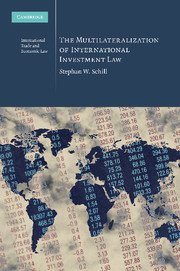Book contents
- Frontmatter
- Contents
- Preface
- List of figures
- Table of treaties, draft instruments, and related documents
- Table of cases
- I Introduction: globalization and international investment law
- II The dynamics of multilateralism and bilateralism in international investment relations
- III Treaty negotiation and multilateralization of international investment law
- IV Multilateralization through most-favored-nation treatment
- V Multilateralization and corporate structuring
- VI Multilateral enforcement of international investment law
- VII Multilateralization through interpretation: producing and reproducing coherence in investment jurisprudence
- VIII Conclusion: multilateralization – universalization – constitutionalization
- Bibliography
- Index
II - The dynamics of multilateralism and bilateralism in international investment relations
Published online by Cambridge University Press: 06 January 2010
- Frontmatter
- Contents
- Preface
- List of figures
- Table of treaties, draft instruments, and related documents
- Table of cases
- I Introduction: globalization and international investment law
- II The dynamics of multilateralism and bilateralism in international investment relations
- III Treaty negotiation and multilateralization of international investment law
- IV Multilateralization through most-favored-nation treatment
- V Multilateralization and corporate structuring
- VI Multilateral enforcement of international investment law
- VII Multilateralization through interpretation: producing and reproducing coherence in investment jurisprudence
- VIII Conclusion: multilateralization – universalization – constitutionalization
- Bibliography
- Index
Summary
The history of international investment law in the post-Second World War period is characterized by repeated failures to establish multilateral treaty rules that govern relations between foreign investors and host States. In particular, imposing substantive limitations on the public authority of host States on a multilateral basis, such as rules concerning expropriations and other investor rights, has proved to be futile. Since 1945 several attempts to conclude a multilateral investment treaty have failed in various for a, caused primarily by the opposition of developing countries who considered that such rules would infringe their sovereignty. Only two multilateral conventions relating to questions of foreign investment succeeded, without, however, imposing any substantive limitations on the host State's treatment of foreign investors. Consequently, multilateralism in international investment relations appears to be a rather limited phenomenon. In sharp contrast, we have witnessed a veritable proliferation of bilateral and regional treaties that impose the very same substantive restrictions on host States regarding treatment and regulation of foreign investment that have failed to materialize on a multilateral basis.
These clearly contradictory developments may be explained by two hypotheses. Either States, in particular developing countries, derive specific benefits from bilateral cooperation that cannot materialize in multilateral settings, or multilateral negotiations allow developing countries to pool their negotiating power in order to resist legal standards that they are not able to decline in bilateral negotiations. Bilateralism and multilateralism in investment cooperation would thus be a function of the varying relative negotiation powers of capital-exporting and capital-importing States, depending on whether they negotiate individually or collectively.
- Type
- Chapter
- Information
- The Multilateralization of International Investment Law , pp. 23 - 64Publisher: Cambridge University PressPrint publication year: 2009

